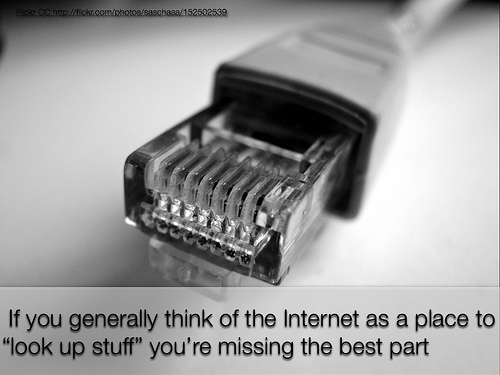‘Our students are changing … but schools are not.’
This is a leitmotif of a professional development program, Powerful Learning Practice (PLP) run by Sheryl Nussbaum-Beach and Will Richardson, which will run in Australia soon, and in which our school has the privilege of participating.
As stated on the PLP website, ‘Powerful Learning Practice offers a unique opportunity for educators to participate in a long-term, job-embedded professional development program that immerses them in 21st Century learning environments. The PLP model is currently enabling hundreds of educators around the country to experience the transformative potential of social Web tools to build global learning communities and re-envision their own personal learning practice’.
As a result of our participation in the Web2.0 program through School Library Association of Victoria, we were invited by Jenny Luca, who is organising the Australian contingent of the 100 educator-strong global cohort , to join the 7 or 8 Australian teams of 5 educators per school. We almost jumped for joy, but remembered our respectable standing and did some mental leaps instead. After all, how long had we been passionate about transformative learning environments, recognising the potential of emerging web technologies in engaging students and creating global learning communities? And how difficult it is to create a voice that is heard above the clatter of the old school machine? How helpless and ineffective we often feel, like door-to-door evangelists in our own schools, with the door being slammed in our faces, people telling us they have their own god, or that they have no time to listen. At best, we’ve ‘converted’ small, isolate pockets of educators but not had any significant effect on the school community.
Now we have the opportunity to take part in a program based on a highly successful pilot carried out in Alabama and supported by internationally recognised practitioners of 21st century learning technologies. Not only has this given us the opportunity to formulate our thoughts in a proposal to the principal class, but it has also created interest from staff, led to conversations where we have had to explain and justify the cause, and opened up planning for a collaborative team. Suddenly we had something that was worth doing across the school, that was supported both from the top and the bottom. We weren’t isolated any more!
Two of us were able to attend the initial talk by Sheryl Nussbaum-Beach at Toorak College this afternoon. I was excited to meet Jenny and Sheryl, and they were as passionate and inspiring as I had expected. Sheryl was amazing – stepping off the plane and straight into the talk, her body clock still at 3am, and engaging the audience with her passion and ideas. I asked her how she managed to deliver an hour-long talk after travelling halfway across the world, and she said that her tiredness was evident in her slower than usual speech, which, for us in Australia, was a comfortable speed to follow.
I thought I’d mention some of the things that stood out for me as I listened to Sheryl’s presentation. Firstly, she emphasised that 21st century learning, although based on technologies, was primarily a human network. These technologies enable global connections and wisdom of the crowd. Sheryl gave the example of Twitter as a means of finding the best information about buying a new car. I suppose it’s an extension of the network of friends and colleagues people turn to when looking for a good car, or finding a good plumber, only the global aspect facilitates expert knowledge more effectively. In a fast-changing world, where the information today will be outdated tomorrow, rather than teach memorisation of content from a single text, we need to teach students how to work collaboratively. As Sheryl said, ‘don’t think computers, think innovation’. Our students need to be able to be productive, self-directed and effective communicators, understanding digital communications, and not be overwhelmed by the fast pace of change in their lives. It’s not about the tools, the technology, but about learning.
Sheryl challenged us about the relevance of school education, and spoke about the low percentage of students who thought that what they had learned at school would be relevant to their future lives. She spoke about the learning that takes place outside of school within the networking communities of young people. We saw Darren Draper’s film that asked educators if they had been paying attention to students in their classes, if they had been watching them or listening to them, and challenged educators to use the technologies that these students loved in order to teach and engage them.
What inspired me, towards the end of the talk, was Sheryl’s prediction that members of the PLP cohort would eventually have the courage to be bold and challenge the status quo. How true, that, in order to inspire change, we have to model it. As Sheryl said, ‘you can’t give away what you do not own’. I’m ready to share what I’ve learned. I’m not learning to keep. It isn’t much, and so I’m also ready to keep learning. We need to keep up with the pace of change. We hope to help diminish the digital divide – between those who know how to collaborate digitally, as the world shrinks through global connections, and those who don’t. Our job is to prepare students to be responsible, global citizens. We need a change in pedagogy, playing to students’ strengths instead of their weaknesses (ie. what they don’t know, what they’re not good at). We need to cater for different learning styles. We must become 21st century educators. These are the main ideas from Sheryl’s deep-reaching talk today.
What I’d like to say to teachers is what I read on Darren Draper’s excellent blog, when he talked about Kevin Honeycutt and one of his ‘favorite quotes regarding teachers and our relationship to our students: “We’ve got to be willing to play where they play… even if we don’t feel comfortable.” ‘
I’m looking forward to an enriching, collaborative, global PLP experience.




